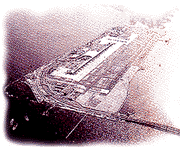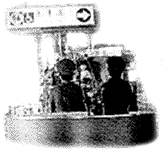Air travel purists might be appalled by these
earthbound commercial concerns, but face worse horrors ahead. London's Gatwick, for
example, has unveiled plans for a $40 million "airport theme park" which, when it opens
in 1996, will be visited by one million people a year who have no intention of traveling
anywhere except to the airport itself.
Apart from shopping and "leisure," airports are being used ever more
intensively by businesses. Virtual corporations - companies that have forsaken
their headquarters for a life on the road - are big users of airports. The
increased business conducted across national boundaries in the so-called "New
Economy" has fueled demand for meeting rooms, exhibition and showroom
facilities, business centers and other non-travel-specific facilities inside,
next to, under, and on top of, most new airports. Airports have replaced
green-field science and business parks as the epicenter of business real
estate.
These multiple programs and agendas - operational, commercial, political - are
one reason why writers have started talking about airports as cities of the
air. Both cities and airports cover large areas; both are a complex of
intersecting transport systems, economies, buildings, and people. But there is
one crucial difference: cities have inhabitants. At airports everyone is
transient. Herein lies one element of the airport's existential ambiguity.
 A spectacular example of this trend is Kansai
International Airport, which opened in September 1994. It's a $15 billion
phenomenon described even by the can-do Japanese as "an exceptional endeavor for the country."
The 500 hectare airport has a projected capacity for 160,000 aircraft movements a year, and is
built on an artificial island about 5 km offshore from Osaka -- the most
feasible option since the densely populated country is quite mountainous. The
average water depth at the site is 18.5m, with unstable clay underneath.
Preparation of the site began in 1987, and involved driving one million sand
piles into the sea bed. They then built an 11km long sea wall, which outlined
the island, and filled the resulting hole with 164 million cubic meters of
soil. It must have taken a lot of buckets and spades.
A spectacular example of this trend is Kansai
International Airport, which opened in September 1994. It's a $15 billion
phenomenon described even by the can-do Japanese as "an exceptional endeavor for the country."
The 500 hectare airport has a projected capacity for 160,000 aircraft movements a year, and is
built on an artificial island about 5 km offshore from Osaka -- the most
feasible option since the densely populated country is quite mountainous. The
average water depth at the site is 18.5m, with unstable clay underneath.
Preparation of the site began in 1987, and involved driving one million sand
piles into the sea bed. They then built an 11km long sea wall, which outlined
the island, and filled the resulting hole with 164 million cubic meters of
soil. It must have taken a lot of buckets and spades.
Meanwhile, Renzo Piano, working with engineers Ove Arup and partners, won an
international competition for the 300,000 m2 terminal. The central concept, the
geometry of the main roof, was inspired by an airflow design and developed with
reference to fractal geometry. Renzo Piano believes that an "air terminal
should be structured as a diagram of the people moving through it. The entire
building - structure, light and air movement - should complement the logic of
passenger movement." To its credit, the airport has also segregated commercial
activities on another level, allowing passengers more or less uninterrupted
access from landside to airside. The 82.5m-long main beams over the 300m long
main halls will afford travelers the pleasure of being part of a moving throng
in a great space. The roof is airy and uncluttered and full of light. The
design allows people to experience a drama of changing space, light and sights,
familiarity intermixed, as the jury report put it, with "bold revelations of
the future." Passengers arriving from the mainland will enter a great 'canyon'
- the interface between nature and the machine - some 25m wide and 300m long
with escalators, lifts and bridges slung between the four public halls.
At their first briefing meeting, Piano's team was presented with a 2,000 page
summary of the technical briefing. As legend has it, the great man
ceremoniously threw this $50 million document in the trashbin -- implying that
he needed to start with, and hold onto, a clear design concept, and that the
details could be worked out later. Amazingly, the design concept has survived a
vast, fast, multi-billion dollar program more or less intact.
Kansai has successfully emerged as an architecturally coherent building. But
the opportunity to spend $10 billion building a new island is not an option for
most airport developers in the world. So the third design problem I want to
discuss - the so-called cognitive dissonance that comes from being a rootless
monad in an opaque system - is likely to remain pervasive in airports around
the world unless new design strategies are developed.
 Countless modern scholars, from Karl Marx to Baudelaire to Richard Sennett,
have written about the alienation people feel in modern cities. Urban anxiety
is part of our culture, almost familiar by now. But scientists have only
recently addressed the phenomenon, having discovered the importance of what
Hubert Dreyfus calls "situated understanding": the notion that a clear mental
picture of the whole artificial environment contributes to mental health.
Countless modern scholars, from Karl Marx to Baudelaire to Richard Sennett,
have written about the alienation people feel in modern cities. Urban anxiety
is part of our culture, almost familiar by now. But scientists have only
recently addressed the phenomenon, having discovered the importance of what
Hubert Dreyfus calls "situated understanding": the notion that a clear mental
picture of the whole artificial environment contributes to mental health.
When it comes to giving us a "clear mental picture" of our environment,
architecture has not exactly done a great job in recent decades. Design
responses to the problem of complexity have tended to adopt one of three
approaches:
1 - embrace it/celebrate it
2 - hide it
3 - make it familiar, reassuring, and homely
After a pre-history involving utilitarian brick buildings, airports seemed
destined to become the architectural equivalent of modern cathedrals. Eero
Saarinen's TWA terminal in New York had an particularly strong impact on the
public imagination. But as Reyner Banham so memorably observed , the TWA
terminal was obsolete before it even opened. Designed for fleets of
propeller-driven Lockheed Constellations, by the time it opened the first
Comets and Boeing 707s were already in use, and the terminal's airside had to
be encrusted with jet-blast deflectors.
Airports have been struggling unsuccessfully to catch up ever since. Planners,
besieged by data, normally think in terms of boxes. Occasionally someone has at
least thought about system complexity when designing an airport: the result -
for example at Roissy Charles de Gaulle - has often looked stunning on paper
but been a nightmare to use. I must have passed through Roissy 30 times and I
still have to ask where to catch the railway shuttle.
- 
 +
+
 A spectacular example of this trend is Kansai
International Airport, which opened in September 1994. It's a $15 billion
phenomenon described even by the can-do Japanese as "an exceptional endeavor for the country."
The 500 hectare airport has a projected capacity for 160,000 aircraft movements a year, and is
built on an artificial island about 5 km offshore from Osaka -- the most
feasible option since the densely populated country is quite mountainous. The
average water depth at the site is 18.5m, with unstable clay underneath.
Preparation of the site began in 1987, and involved driving one million sand
piles into the sea bed. They then built an 11km long sea wall, which outlined
the island, and filled the resulting hole with 164 million cubic meters of
soil. It must have taken a lot of buckets and spades.
A spectacular example of this trend is Kansai
International Airport, which opened in September 1994. It's a $15 billion
phenomenon described even by the can-do Japanese as "an exceptional endeavor for the country."
The 500 hectare airport has a projected capacity for 160,000 aircraft movements a year, and is
built on an artificial island about 5 km offshore from Osaka -- the most
feasible option since the densely populated country is quite mountainous. The
average water depth at the site is 18.5m, with unstable clay underneath.
Preparation of the site began in 1987, and involved driving one million sand
piles into the sea bed. They then built an 11km long sea wall, which outlined
the island, and filled the resulting hole with 164 million cubic meters of
soil. It must have taken a lot of buckets and spades.
 Countless modern scholars, from Karl Marx to Baudelaire to Richard Sennett,
have written about the alienation people feel in modern cities. Urban anxiety
is part of our culture, almost familiar by now. But scientists have only
recently addressed the phenomenon, having discovered the importance of what
Hubert Dreyfus calls "situated understanding": the notion that a clear mental
picture of the whole artificial environment contributes to mental health.
Countless modern scholars, from Karl Marx to Baudelaire to Richard Sennett,
have written about the alienation people feel in modern cities. Urban anxiety
is part of our culture, almost familiar by now. But scientists have only
recently addressed the phenomenon, having discovered the importance of what
Hubert Dreyfus calls "situated understanding": the notion that a clear mental
picture of the whole artificial environment contributes to mental health.

 +
+